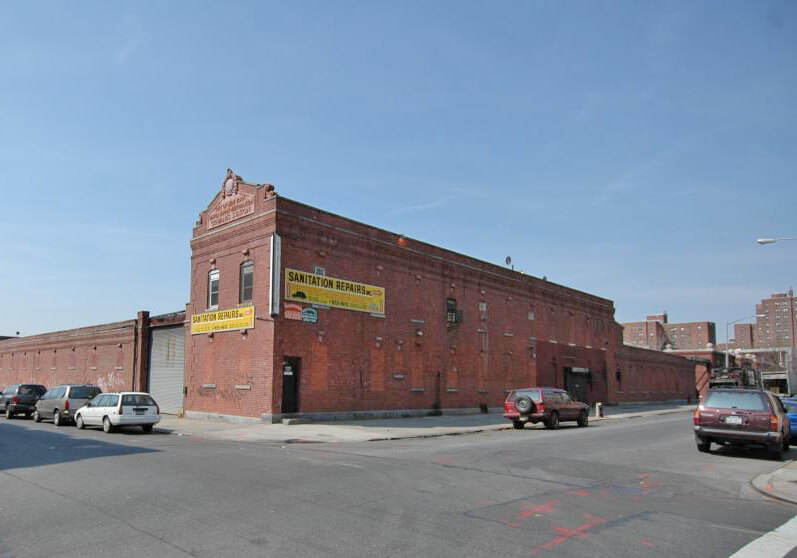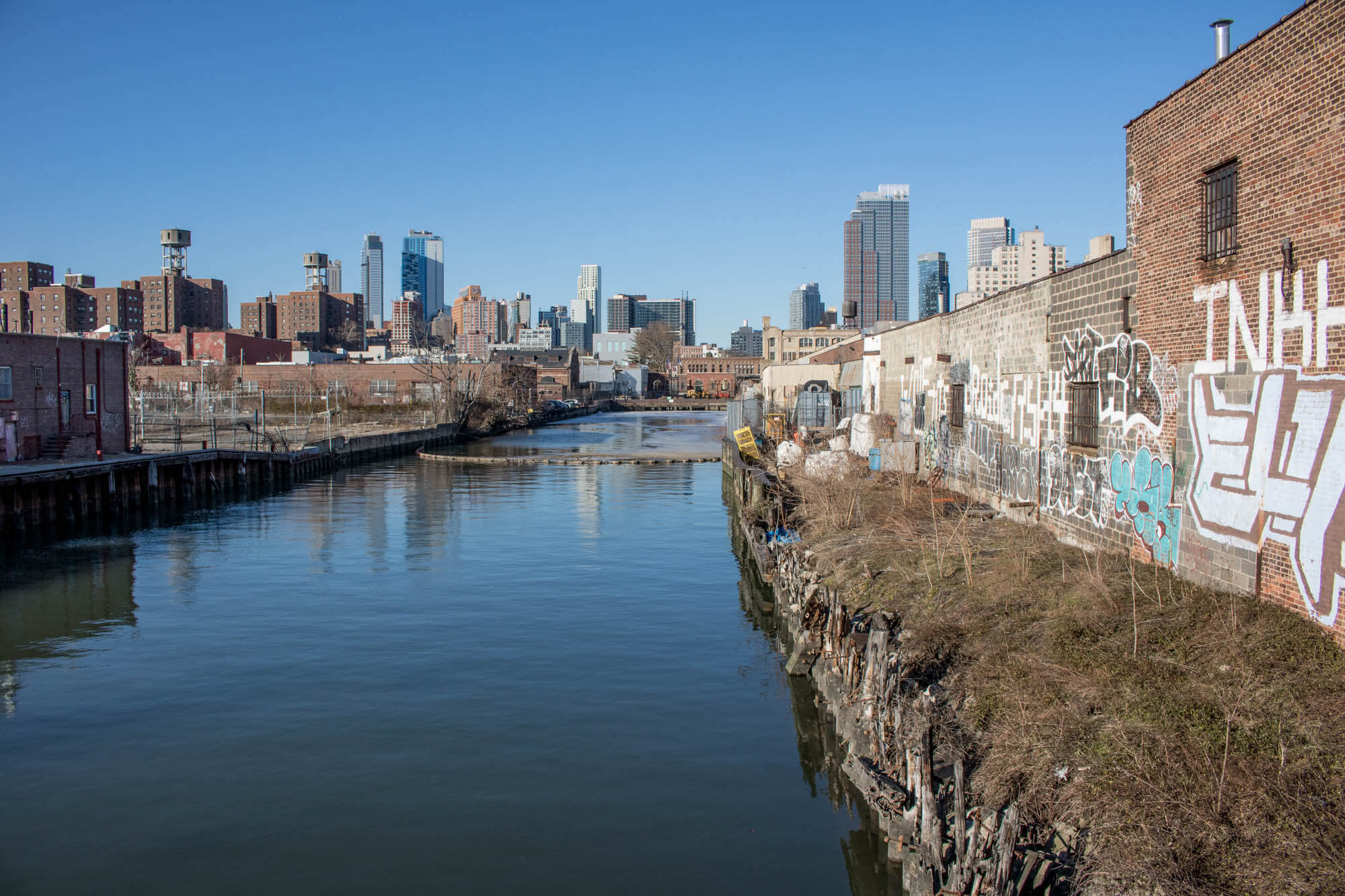LPC Nixes Plan to Landmark Historic Gowanus Station, Threatened With Demo by Cleanup
The LPC has rejected pleas from Gowanus residents to landmark the Gowanus Station, a Beaux-Arts brick industrial building at the center of the controversy over the cleaning up and developing of Gowanus.

The cornice of the Gowanus Station. Photo via Brad Vogel
The LPC has rejected pleas from Gowanus residents to landmark the Gowanus Station, a Beaux-Arts brick industrial building at the center of the controversy over the cleaning up and developing of Gowanus.
Brad Vogel and Linda Mariano, both Gowanus residents, submitted separate requests for evaluation (RFE) for the building in September.
The Beaux-Arts brick industrial building at 234 Butler Street was built by the city in 1913 as a pumping station for the canal, and is now privately owned. Depending on which of several EPA proposals to clean up the canal goes forward, the Gowanus Station could be demolished to make way for an underground sewage storage tank.
It’s an “iconic building imbued with neighborhood character,” a concerned group of local residents said in a November press release.
“This magnificent building is over 100 years old,” Linda Mariano of Friends and Residents of Greater Gowanus said in the release. “Its design and sculptural elements tie directly into the history of the Gowanus neighborhood’s relationship with water. It can and should be saved.”

The building is already part of the National Register-eligible Gowanus Historic District. In October, the State Historic Preservation Office sent a letter to the EPA asking the building be saved.
“The building…has overarching significance for the National Register eligible Gowanus Historic District,” said that letter. “Its demolition would adversely affect both the building and the National Register eligible Gowanus Canal Historic District. To destroy this intact, architecturally distinctive example of Brooklyn’s civic and industrial heritage would be a
disservice to the Gowanus neighborhood and to the city as a whole.”
But the building is utilitarian and too altered to merit landmarking, according to the LPC. Lisa Kersavage, the Director of Strategic Planning and Special Projects at the LPC, wrote in a December 11 letter:
We have carefully reviewed whether this building may merit consideration for designation, and found that as a plain utilitarian building that has been highly altered it lacks the necessary architectural significance and integrity to rise to the level of an individual landmark.
The Pumping Station and Service Building at 234 Butler Street (aka 226 Nevins Street) was built in 1913 by the City’s Department of Water supply, Gas & Electricity. It is a plain and utilitarian brick structure, with a sign on its Nevins Street facade that reads “City of New York/Water Supply-Distribution/Gowanus Station.” Alterations over time have seriously impacted the building’s integrity. Nearly all of the building’s existing openings have been extensively altered, with a range of infill and changes in opening sizes and placement. Modifications made to the building in the 1970s include a utilitarian brick addition.
Research shows that this building changed ownership and use many times since it was built. While its original ownership indicates a historical association with the Gowanus Canal, there are other buildings, such as the Gowanus Flushing Tunnel Pumping Station and Gate House located at 201 Douglass Street (Brooklyn Block 411, Lot 14), that have much stronger associations with the history and engineering of the canal, and also a greater architectural merit.
The agency is currently undertaking a comprehensive survey of the Gowanus area, and will be seeking to identify historic preservation opportunities within the neighborhood.

Vogel said he was not convinced, especially considering New York’s State Historic Preservation Office says the building is significant, and wonders if the LPC response was influenced by the cleanup plans. In a response to the rejection letter, he wrote:
The justifications provided in the letter are flimsy and perfunctory. The letter is written in such a way as to minimize the architectural value the building exhibits to the extent that one cannot help but wonder if this denial was more about the CSO tank and less about considering historic resources. It does not seem like a serious consideration by the Commission, especially in light of the various surveys and commentators that have identified the building as being architecturally and historically significant — as well as the Oct. 19, 2017 letter from SHPO to EPA that states the same conclusion quite clearly.
For example, the LPC letter dismisses the building repeatedly as being “utilitarian” without noting or describing its elaborate ornamentation or materials other than mentioning that words appear on the facade. It does not mention the ornamentation along the Butler Street facade. All of this unmentioned ornament situates the building’s architectural style in the Beaux-Arts. What’s more, the city has landmarked other buildings that are arguably even more utilitarian in nature — see, for example, the Betsy Head Play Center where the designation report notes the use of “low-cost building materials, principally brick and cast concrete”.
The letter emphasizes alterations to the building, but such alterations — chiefly infilled openings — are easily reversible and are not nearly as significant as the letter suggests. The letter gives short shrift to the entire history of use of the building, noting only that “this building changed ownership and use many times since it was built” — but that, really, is part of the nature of the story of industry that defines Gowanus and a serious review would have mined the ore in such a pedigree. The letter also attempts to downplay Gowanus Station because there are other buildings in the area that ostensibly have greater architectural merit and stronger historical associations. It’s a strange argument because the Pumping Station and Gatehouse the Commission references as an example is not a designated city landmark and there are very few city-designated landmarks at all in Gowanus proper.
The letter also notes that LPC is undertaking a comprehensive survey of the Gowanus area, as if this should mitigate the loss of Gowanus Station. Instead, it raises yet another question: If there is currently a comprehensive survey underway that has not yet concluded, then why is LPC jumping to the conclusion now that this building — which the community has shown it finds designation-worthy — is so decidedly unworthy of designation?
The building is at least the second Brooklyn site rejected in a month by LPC. The commission this month said Walt Whitman’s residence at 99 Ryerson Street in Wallabout is not worthy of being considered for landmarking. Vogel was the applicant on that request.
Related Stories
- Concerned Residents Urge the EPA to Save the Gowanus Station
- Gowanus Residents Question the Most Polarizing Issue of the Canal Cleanup
- This Gowanus Factory Has History All Boxed Up
Email tips@brownstoner.com with further comments, questions or tips. Follow Brownstoner on Twitter and Instagram, and like us on Facebook.









What's Your Take? Leave a Comment